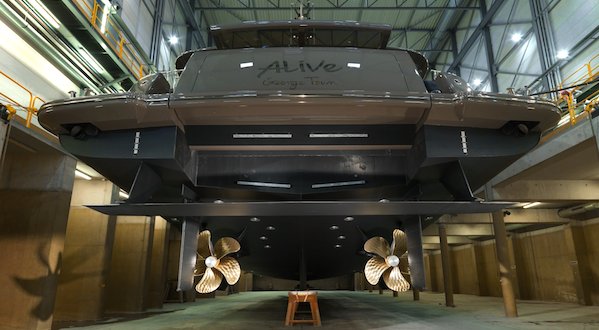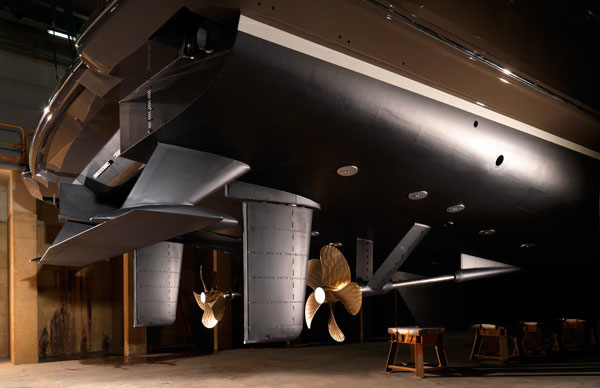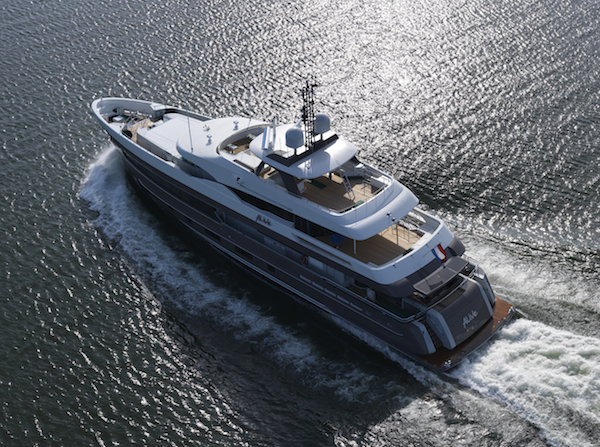Hull Vane 'Alive' and kicking
The Hull Vane fixed stern foil has been successfully implemented onto a number of different vessels and the results are extremely promising. SuperyachtNews.com explains how and why.…
The Hull Vane, designed and patented by Dr Pieter van Oossanen, is a fuel, energy and cost saving fixed stern foil. The Hull Vane is designed to achieve lift in the upward flow under the aft section of the vessel. What differentiates this foil from others is its positioning to achieve a lift vector with a forward-facing component, the beneficial effects of which are fourfold.
The fuel-saving capabilities of the Hull Vane are achieved thanks to four distinct byproducts; thrust, wave reduction, trim correction and reduced pitching. The Hull Vane is able to recover energy from the ascending water flow near the stern of the vessel. The lift force that is subsequently produced contains a forwards-oriented component that — when in excess of the foils resistance — creates an increase in net thrust force on the vessel. Unlike traditional hydrofoils, the Hull Vane is not used to lift the entire boat (as on hydrofoiling ships) or the stern (as on trim, tabs, interceptors, trim wedges and so on) vertically out of the water, but uses the lift to create forward thrust on displacement and semi-displacement vessels.
By accelerating the water flow over the hydrofoil, the stern wave of the vessel is reduced, much like a bulbous bow reduces the bow wave. Indeed the Hull Vane has been referred to as “the bulbous bow of the stern”. The wave pattern produced by a yacht is a reflection of the energy being spent by the propulsion system. Therefore a reduction in the stern wave as a result of the lower pressure created by the Hull Vane highlights a reduction in fuel consumption due to decreased wavemaking resistance.
The vertical lift also reduces running trim and keeps the yacht closer to even keel when travelling at high speeds. At higher speeds the bow raises and the stern lowers, which creates unfavourable drag. The Hull Vane provides an antithesis to this negative byproduct.
Finally the Hull Vane reduces pitching (rotation around a transversal axis), rolling (rotation around a longitudinal axis) and yawing (rotation around a vertical axis) motions. The damping effect reduces the surplus movement of the vessel, therefore decreasing additional resistance and further reducing the energy required by the propulsion system. The improvements in seakeeping have made the Hull Vane an intriguing option for vessels within and beyond the superyacht industry. Rotation reductions across the axes make the Hull Vane an attractive product for offshore supply vessels, crew boats and ferries. Any vessel that requires launching helicopter operations and/or tenders and ribs would benefit from increased stability. Not to mention less guests feeling ill on board.
The Hull Vane has now been applied to a 30m catamaran, 55m supply vessel and Heesen’s 42m Alive. Using computational fluid dynamics the Hull Vane team has calculated that resistance is reduced by 20 per cent on Alive, which in turn decreases fuel consumption and increases her nautical range on the same tank volume.
Successful tests have also been done on the 55m supply vessel, the results supported predictions and confirmed fuel savings of 10 per cent at 12 knots and 15 per cent at 21 knots. Testing also revealed a 50 per cent reduction in overshoot during the 10-degree zig-zag test. Whether the reduction in yawing is largely a result of the vertical supports or the wing itself remains to be seen. What is certain is that the effect is welcomed. A less noticeable, but nonetheless note worthy result of the Hull Vane is a reduction in noise. With less power output required by the propulsion systems, a net reduction in sound is achieved at similar speeds.
After 12 years of research and development, the Hull Vane — technology originally invented for an America’s Cup sailing yacht — has trickled down to the superyacht industry. The nominal additional cost to refit, in tandem with the monetary savings achieved after installation, ensure that the Hull Vane is capable of offsetting the cost of the original investment. While the technology is not suitable for all hull forms, for those that it is, it appears to be an attractive, performance enhancing and economical option. Suitable displacement hulls are those with wide sterns, the inclusion of swimplatforms on most superyachts means they are prime candidates.
The fuel-saving capabilities of the Hull Vane are achieved thanks to four distinct byproducts; thrust, wave reduction, trim correction and reduced pitching. The Hull Vane is able to recover energy from the ascending water flow near the stern of the vessel. The lift force that is subsequently produced contains a forwards-oriented component that — when in excess of the foils resistance — creates an increase in net thrust force on the vessel. Unlike traditional hydrofoils, the Hull Vane is not used to lift the entire boat (as on hydrofoiling ships) or the stern (as on trim, tabs, interceptors, trim wedges and so on) vertically out of the water, but uses the lift to create forward thrust on displacement and semi-displacement vessels.
By accelerating the water flow over the hydrofoil, the stern wave of the vessel is reduced, much like a bulbous bow reduces the bow wave. Indeed the Hull Vane has been referred to as “the bulbous bow of the stern”. The wave pattern produced by a yacht is a reflection of the energy being spent by the propulsion system. Therefore a reduction in the stern wave as a result of the lower pressure created by the Hull Vane highlights a reduction in fuel consumption due to decreased wavemaking resistance.
The vertical lift also reduces running trim and keeps the yacht closer to even keel when travelling at high speeds. At higher speeds the bow raises and the stern lowers, which creates unfavourable drag. The Hull Vane provides an antithesis to this negative byproduct.
Finally the Hull Vane reduces pitching (rotation around a transversal axis), rolling (rotation around a longitudinal axis) and yawing (rotation around a vertical axis) motions. The damping effect reduces the surplus movement of the vessel, therefore decreasing additional resistance and further reducing the energy required by the propulsion system. The improvements in seakeeping have made the Hull Vane an intriguing option for vessels within and beyond the superyacht industry. Rotation reductions across the axes make the Hull Vane an attractive product for offshore supply vessels, crew boats and ferries. Any vessel that requires launching helicopter operations and/or tenders and ribs would benefit from increased stability. Not to mention less guests feeling ill on board.
The Hull Vane has now been applied to a 30m catamaran, 55m supply vessel and Heesen’s 42m Alive. Using computational fluid dynamics the Hull Vane team has calculated that resistance is reduced by 20 per cent on Alive, which in turn decreases fuel consumption and increases her nautical range on the same tank volume.
Successful tests have also been done on the 55m supply vessel, the results supported predictions and confirmed fuel savings of 10 per cent at 12 knots and 15 per cent at 21 knots. Testing also revealed a 50 per cent reduction in overshoot during the 10-degree zig-zag test. Whether the reduction in yawing is largely a result of the vertical supports or the wing itself remains to be seen. What is certain is that the effect is welcomed. A less noticeable, but nonetheless note worthy result of the Hull Vane is a reduction in noise. With less power output required by the propulsion systems, a net reduction in sound is achieved at similar speeds.
After 12 years of research and development, the Hull Vane — technology originally invented for an America’s Cup sailing yacht — has trickled down to the superyacht industry. The nominal additional cost to refit, in tandem with the monetary savings achieved after installation, ensure that the Hull Vane is capable of offsetting the cost of the original investment. While the technology is not suitable for all hull forms, for those that it is, it appears to be an attractive, performance enhancing and economical option. Suitable displacement hulls are those with wide sterns, the inclusion of swimplatforms on most superyachts means they are prime candidates.
Profile links
Click here to become part of The Superyacht Group community, and join us in our mission to make this industry accessible to all, and prosperous for the long-term. We are offering access to the superyacht industry’s most comprehensive and longstanding archive of business-critical information, as well as a comprehensive, real-time superyacht fleet database, for just £10 per month, because we are One Industry with One Mission. Sign up here.






